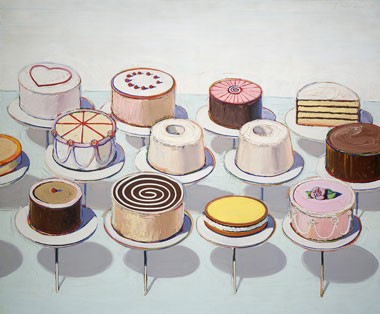Grade Level: 2–4
Using the painting, Cakes by artist Wayne Thiebaud, students will practice fractions, addition, subtraction, word and money problems, sorting, and classifying. Then they will create a bold cake painting, either online or with classroom art materials.

Wayne Thiebaud
American, born 1920
Cakes, 1963
oil on canvas, 152.4 x 182.9 cm (60 x 72 in.)
National Gallery of Art, Gift in Honor of the 50th Anniversary of the National Gallery of Art from the Collectors Committee, the 50th Anniversary Gift Committee, and The Circle, with Additional Support from the Abrams Family in Memory of Harry N. Abrams
Curriculum Connections
Materials
Warm-Up Questions
Have you ever seen a scene like this? What seems unusual about it? (Note the thin, delicate stands—almost like a circus performer balancing plates on a straw!)
Background

Wayne Thiebaud, c. 1985–1986
©Wayne Thiebaud/Licensed by VAGA, New York, NY

Wayne Thiebaud
American, born 1920
Eight Lipsticks, 1988
drypoint on Somerset Satin paper, 17.8 x 15.2 cm (7 x 6 in.)
National Gallery of Art, Gift of Kathan Brown
8. Thiebaud painted things other than food. He made still lifes of neckties, eyeglasses, lipsticks, even cows and dogs. He also painted large portraits of human figures, applying thick paint in bright colors against stark white backgrounds.
9. Thiebaud went on to paint cityscapes—from the steep hills of San Francisco to the colorful landscapes of the Sacramento Valley in California.
10. Wayne Thiebaud retired from full-time teaching in 1990. He lives in Northern California and continues to paint.
Guided Practice
Begin by looking carefully at the painting Cakes by Wayne Thiebaud with your students. Display a copy of the painting and ask students:
Read the facts “Ten Things About Thiebaud” at the very beginning of the lesson and ask students what they learned about the artist that might help explain his painting.
How hungry are you? Unless you are really hungry (and can eat the whole thing!), a cake is usually cut into equal pieces—or fractions—of the whole when it is served. Thiebaud gives us lots of clues on how to cut his cakes.
The Boston Cream Pie is the low one with a creamy white filling; it looks more like a pie than a cake. Imagine how this cake looked before the filling was put between the layers.
This cake is divided into two layers. Each layer represents one half (1/2) of the total cake. The whole cake consists of two halves (2/2). What does 2/2 equal?
Now look at this layer cake (pictured right):
Return to looking at all the cakes: Which cakes have layers or section marks that show fractions?
Notice the first cake on the left in the middle row: What fraction represents one section of this cake? (1/8)
Now, look at the cakes in the back row. Assume all are four-layer cakes with the same diameter. Which of the choices below is the smallest piece of cake?
By secret ballot (so that they don't influence each other), have each student choose the cake s/he would like most to take home for dinner. Tell them their description of the cake must be very clear.
Collect the ballots. Ask for two volunteers to sort the ballots by cake type and to count the number for each type. On a large sheet of chart paper, make a graph like the one below using the students’ descriptions:
Draw in a bar above each cake type, indicating how many students selected it. Then ask students:
Activity
Now that students are familiar with the painting, have them make their own boldy-designed cake paintings. What type of cake do they like? What shape is their cake? round? rectangular? another shape? What colors are used for this type of cake? How would they decorate it?
Extension
Continue the connections between math and art with these worksheets:
VA:Cr1.1.3 Elaborate on an imaginative idea.
VA:Re1.2.2 Make art or design with various materials and tools to explore personal interests, questions, and curiosity.
VA:Re7.2.3 Determine messages communicated by an image.
VA:Re8.1.2 Interpret art by identifying the mood suggested by a work of art and describing relevant subject matter and characteristics of form.